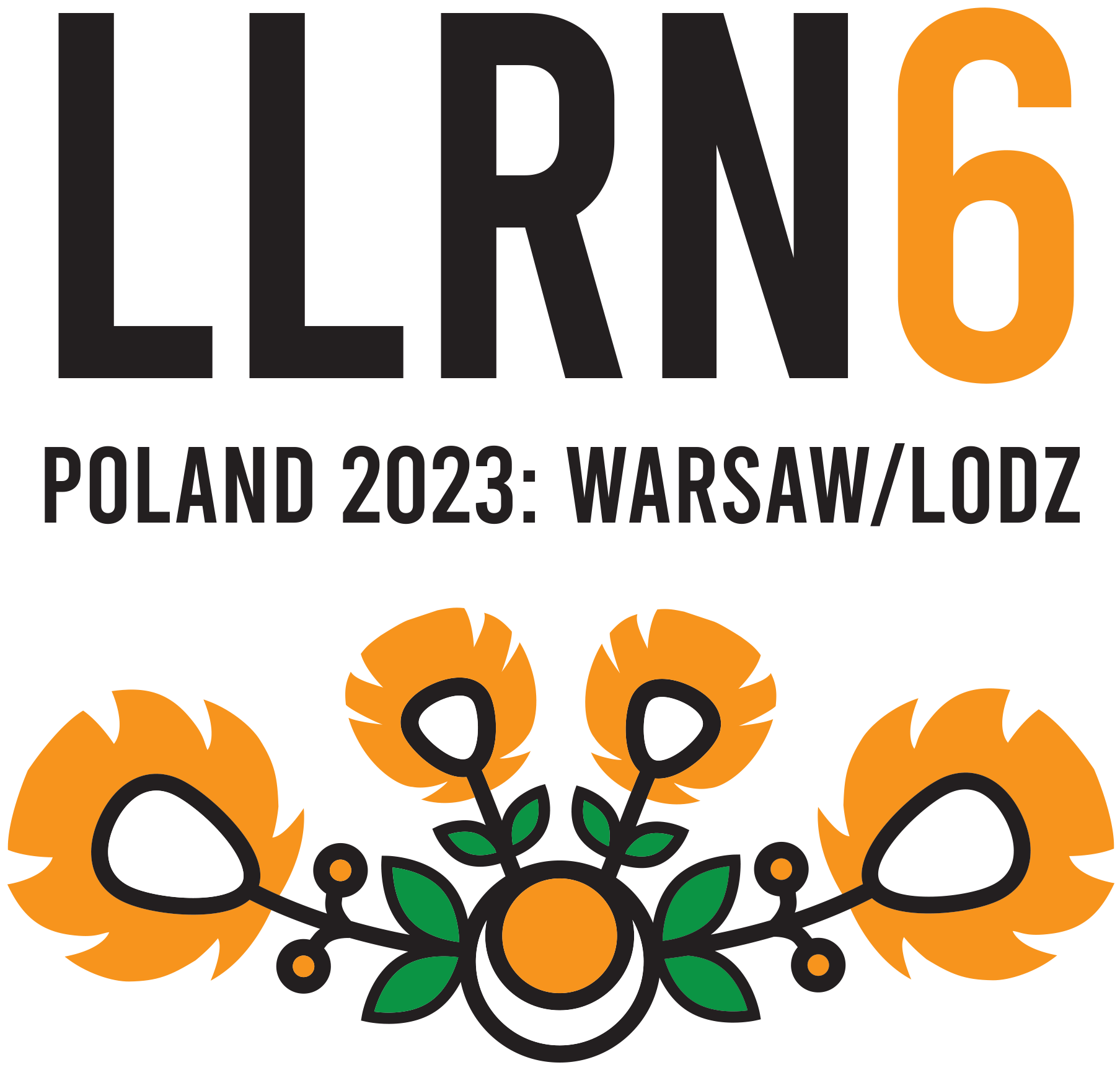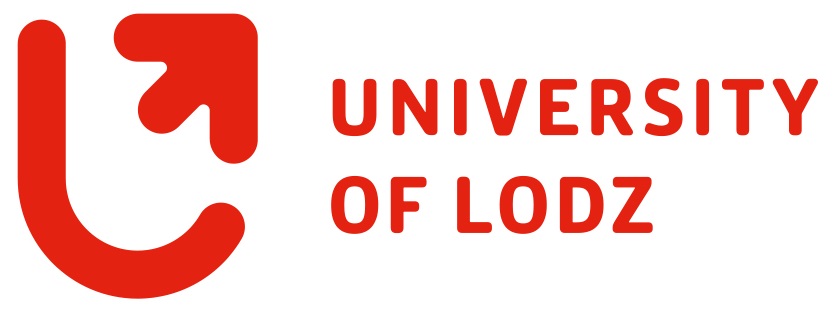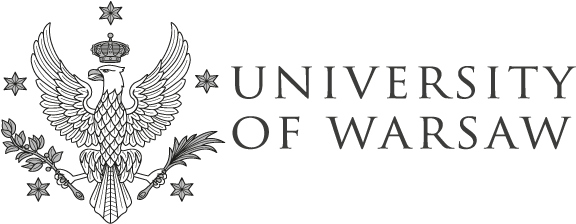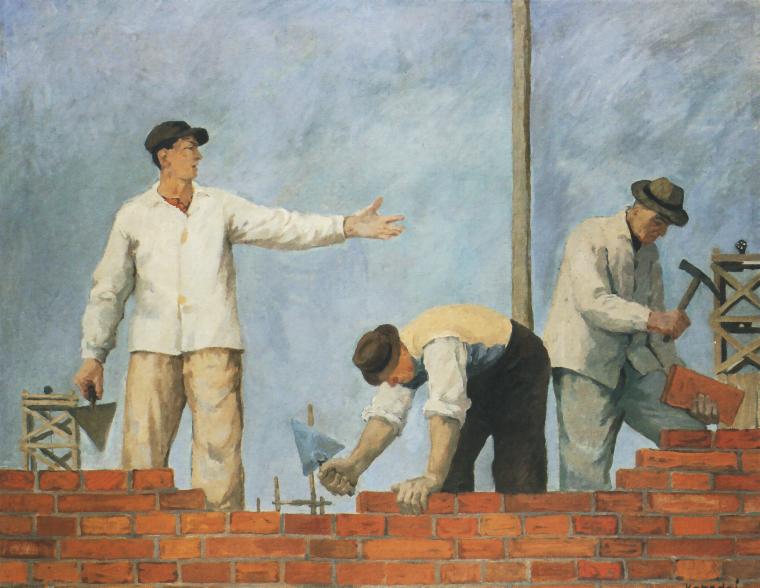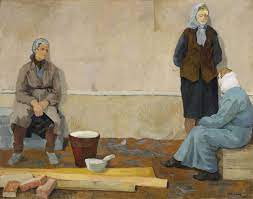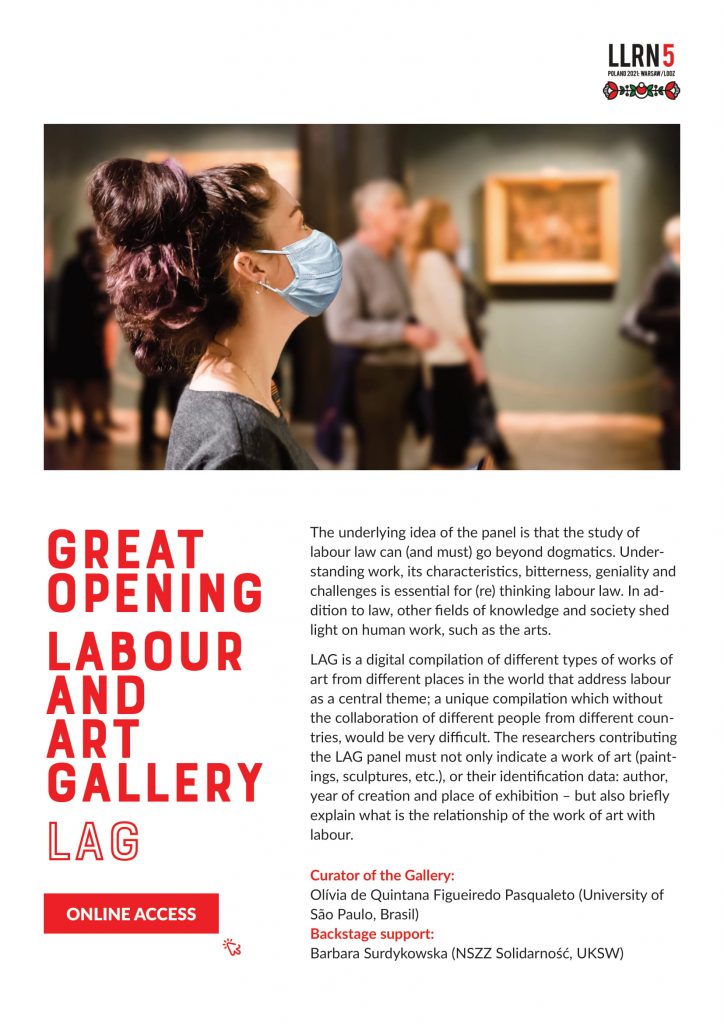
LABOUR AND ART GALLERY (LAG) is a special panel session submitted by Olívia de Quintana Figueiredo Pasqualeto (University of São Paulo, Brasil) and coordinated by Barbara Surdykowska (NSZZ Solidarność, UKSW) on behalf of LLRN5-Polish Team.
The underlying idea of the panel is that the study of labour law can (and must) go beyond dogmatics. Understanding work, its characteristics, bitterness, geniality and challenges is essential for (re) thinking labour law. In addition to law, other fields of knowledge and society shed light on human work, such as the arts.
LAG is a digital compilation of different types of works of art from different places in the world that address labour as a central theme; a unique compilation which without the collaboration of different people from different countries, would be very difficult. The researchers contributing the LAG panel must not only indicate a work of art (paintings, sculptures, etc.), or their identification data: author, year of creation and place of exhibition – but also briefly explain what is the relationship of the work of art with labour.
Discussion about LAG will take place on Monday, 28th, 17:30-19:00.
Special Guests of the discussion:
dr Sylwia Serafinowicz is a Chief Curator at a London-based, non-profit organisation addressing social and political concerns through contemporary art and cultural practices. Serafinowicz has curated numerous exhibitions including We Protect You From Yourselves by Democracia (2020), The Second Coming by Kendell Geers (2019), Unloved by Franko B (2019) Wild at Heart (2018), Shikeith: This Was His Body/ His Body Finally His (2017) and Labor Relations (2016), as well as public programmes in the UK and globally. Between 2014 and 2017 she was Collections’ Curator at Wroclaw Contemporary Museum, Poland. Serafinowicz holds a PhD degree in the History of Art from the Courtauld Institute in 2015, and an MA in the History of Art from the University of Warsaw in 2009. She regularly publishes in the press, exhibition catalogues and books.
dr hab. Joanna Unterschütz is an Associate Professor in the Chair of Law, Division of Labour Law and Social Security at the University of Business and Administration in Gdynia, Poland. Author of numerous publications in the field of national and European labour law, criminal labour law, including human trafficking. Her recent research revolves around collective labour rights in new forms of employment. She has also participated in several international research projects, focused on the protection of fundamental rights and labour law. A member of the Transnational Trade Union Rights Experts Network. She also co-operates with Polish Institute for Human Rights and Business.
dr Anna Szyjkowska-Piotrowska is an Assistant Professor at the Studio of Theory and Experiment at the Faculty of Graphics in the Academy of Fine Arts in Warsaw and an Assistant Professor at the Fryderyk Chopin University of Music.
Philosopher of culture, linguist, translator. Occasionally curates, criticizes, or creates something in writing. She completed MA studies in Philosophy and MA studies in Applied Linguistics with a specialization in English and French at the University of Warsaw. She then obtained a Ph. D degree in Philosophy at the Institute of Philosophy of the University of Warsaw. Author of books (Po-twarz. Przekraczanie widzialności w sztuce i filozofii/After -face. Crossing Visibility in Art and Philosophy; Dyrygując falom. Myślenie w wizualno-muzycznych awangardach/Directing the waves. Thinking in visual and musical avant-gardes), articles and essays on art.
dr Jerzy Wierzbicki graduated from
Archeology at the UAM in Poznan, Poland, later worked as a photographer at
archeological excavations in the Middle East. He
received numerous artistic awards, among others: “Humanity Photo Award” Beijing
China (2004); Newsweek Poland (2002); Polish Press Photo (2003); Kolga Photo
awards (2021)
Since 2007 he lives and works in Sultanate of
Oman. Since 2009 he is a press photographer in the “Times of Oman” and
newspaper “Al Shabiba”. From 2009 till 2014 he was a staff photographer
in “Y Magazine”. In 2015 and 2016 he published in www.MiddleEasteye.net and BBC news. In May
2017 he defended Ph.D thesis in the field of art photography at the
National Film School in Łódź. His works are held in the collections of the
National Museum in Gdansk, National Museum in Wroclaw, Art Museum in Lodz,
Museum of History of Photography in Krakow and Centre of Modern Art „Laznia”
and NOMUS the New Museum of Art in Gdansk in Poland, as well as in private
collections in Poland, EU, USA, Germany, United Kingdom, Israel, Sultanate of
Oman and South Africa.
1)Reporting person: Oleksandr Pryimenko (Kharkiv I.P. Kotlyarevsky National University of Arts, Ukraine)
Title of a piece of art: Barge Haulers on the Volga
Author: Ilya Repin
Type/date: Painting/1870-1873
Current location of the work of art: The State Russian Museum
It refers to labour because…: The painting depicts a group of emaciated and tired people who, with great difficulty, pull the barge to the shore. Hot scorching sun mercilessly over these people

2)Reporting person: Carolina Bonemer Cury (CESIT-UNICAMP, Brazil)
Title of a piece of art: The Kiss of Life
Author: Rocco Morabito
Type/date: Photograph/1967
Current location of the work of art: Jacksonville Journal
It refers to labour because…: This photograph, which won Rocco Morabito a Pulitzer Prize in 1968 for News Photography, shows the moment a lineworker (J.D. Thompson) saves a colleague (Randall G. Champion) by mouth-to-mouth resuscitation while they are both hanging from an utility pole. Randall G. Champion was unconscious and hanging upside down after being electrocuted by a low voltage line. J.D. Thompson saw the accident and ran to revive him by giving him mouth-to-mouth and hitting him on the chest. He was successful, and Champion survived.

3)Reporting person: Carlo Valenti (University of Verona, Italy)
Title of a piece of art: Tornio e telaio (eng: Lathe and loom)
Author: Depero Fortunato
Type/date: Painting/1949
Current location of the work of art: Palazzo Romagnoli – Collezioni del Novecento, Forlì (FC), Italy
It refers to labour because…: The artist shows us two figures engaged in a manual work: on the one hand, a woman enveloped in an emerald green light working on a loom, on the other hand, a man working on a lathe under a fiery red light that represents the metal heaviness of the machine.
In both cases, we can see a symbiotic link between man and machine, in which the latter seems to bind the very bodies of the workers to the workplace. This image can be interpreted as a reminder of the dominant position that machines had assumed over human labour during the industrial revolution. Indeed, technological progress dictates how and when people should work, forcing them to an ever more frenetic pace and incorporating them into their metal structure.
It has been chosen because…: I was thinking about the Futurism idea of labour and machines, so I opted for an old (but yet still current) painting.

4)Reporting person: Anne Trebilcock (Institut für Arbeitsrecht, Univ. Göttingen, Germany)
Title of a piece of art: Bill Foutz, Shiprock Trading Post
Author: Florence Riggs
Type/date: Yarn weaving/1992
Current location of the work of art: Smithsonian American Art Museum
It refers to labour because…: Records traditional commercial activity, with sale of artwork designed and produced by a Native American weaver working at home in a rural area.
It has been chosen because…: Stimulates discussion of capturing the value of labor, including its gender dimension, and perhaps the absence of other means of earning income in indigenous communities.
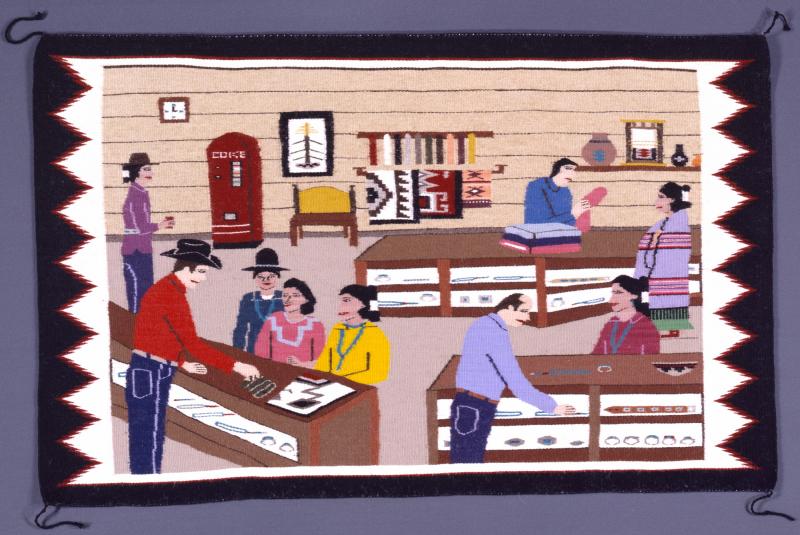
5)Reporting person: Anne Trebilcock (Institut für Arbeitsrecht, Univ. Göttingen, Germany)
Title of a piece of art: – Study for „Ladrilleros”
Author: Pablo O’Higgins
Type/date: Print-lithograph on paper/- 1920-46
Current location of the work of art: Museum of Latin American Art, Long Beach, California, USA
It refers to labour because…: Shows a man and child lifting bricks.
It has been chosen because…: Prods questions: is this child labor? apprenticeship? a father and son building their own home? What legal protections would apply in each case?
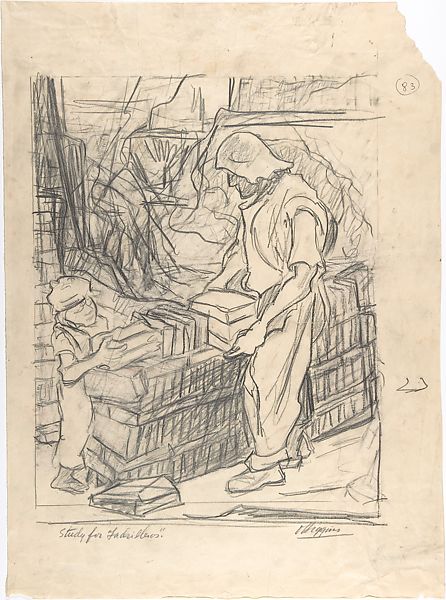
6)Reporting person: Anne Trebilcock (Institut für Arbeitsrecht, Univ. Göttingen, Germany)
Title of a piece of art: Sophie-Merica
Author: Mary Sibande
Type/date: Sculpture (mixed media)/2009
Current location of the work of art: Smithsonian National Museum of African Art, Washington, DC
It refers to labour because…: Domestic worker (Black woman) – too often exempted from labour law.
It has been chosen because…: Stimulates discussion of domestic work (who does it, under which conditions). The maid’s dress becomes a fantasy ball gown, inviting reflection on how she sees her work and life. Could introduce discussion of ILO Convention No. 189 and Recommendation No. 201.
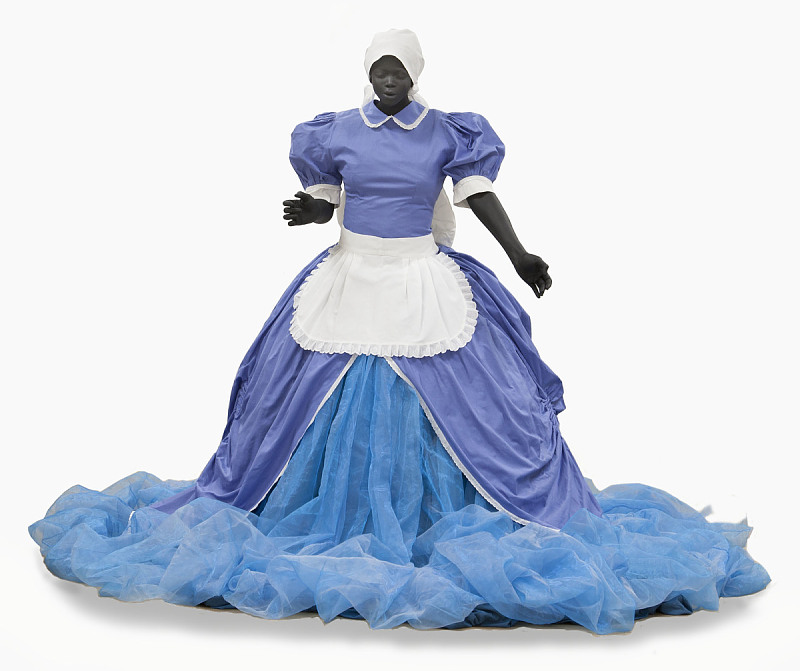
7)Reporting person: Anne Trebilcock (Institut für Arbeitsrecht, Univ. Göttingen, Germany)
Title of a piece of art: Gathering Shellfish
Author: Pitseolak
Type/date: Print/1970s-early 1980s
Current location of the work of art: Sacred Hoop Trading
It refers to labour because…: Traditional shellfish gathering activity in contrast to production for export in global supply chains that sometimes involve child labour and forced labour.
It has been chosen because…: Could be an entry into a discussion of how the ILO Indigenous and Tribal Peoples Convention, 1989 (No. 169) fits in labor law, esp. in connection with the challenges of climate change. And to the use of child labour and forced labour in shellfish gathering today.
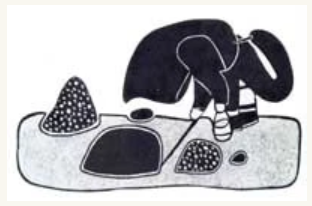
8)Reporting person: Anne Trebilcock (Institut für Arbeitsrecht, Univ. Göttingen, Germany)
Title of a piece of art: The Orchestra at the Opera
Author: Edgar Degas
Type/date: painting/c. 1870
Current location of the work of art: Musée d’Orsay, Paris, France
It refers to labour because…: Illustrates culture as work, as well as sex segregation in it.
It has been chosen because…: Contrast rights/protections of musicians in an orchestra, ballet dancers, and free lancers in the gig economy. Entry for discussion of FNV Kunsten Informatie en Media v Staat der Nederlanden (2014) and intersection of labour law and competition law.
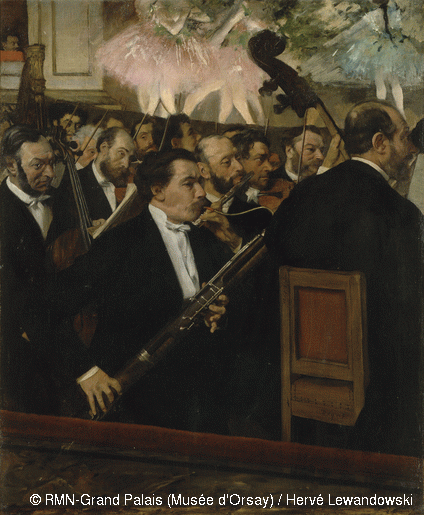
9)Reporting person: Anne Trebilcock (Institut für Arbeitsrecht, Univ. Göttingen, Germany)
Title of a piece of art: March of the Weavers
Author: Käthe Kollwitz
Type/date: Graphic – line etching/1893-97
Current location of the work of art: Käthe Kollwitz Museum, Cologne, Germany
It refers to labour because…: Workers banding together, marching to make demands.
It has been chosen because…: Could open discussion on collective action, impact of technological change, the working poor.
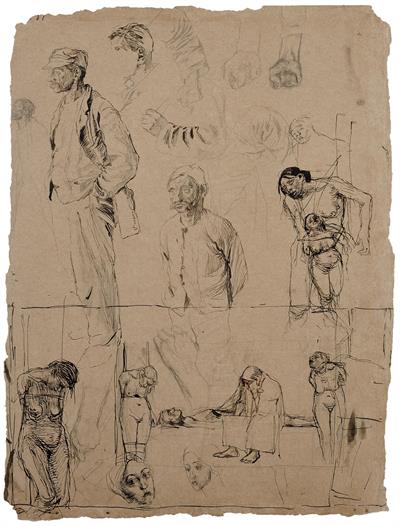
10)Reporting person: Anne Trebilcock (Institut für Arbeitsrecht, Univ. Göttingen, Germany)
Title of a piece of art: The Harvesters
Author: Pieter Brueghel
Type/date: Painting/1565
Current location of the work of art: Metropolitan Museum of Art, New York, USA
It refers to labour because…: Agricultural workers – some working, some resting; pre-international Geneva in the background.
It has been chosen because…: Basis of comparison to agricultural work today; impact of technological change on labour.
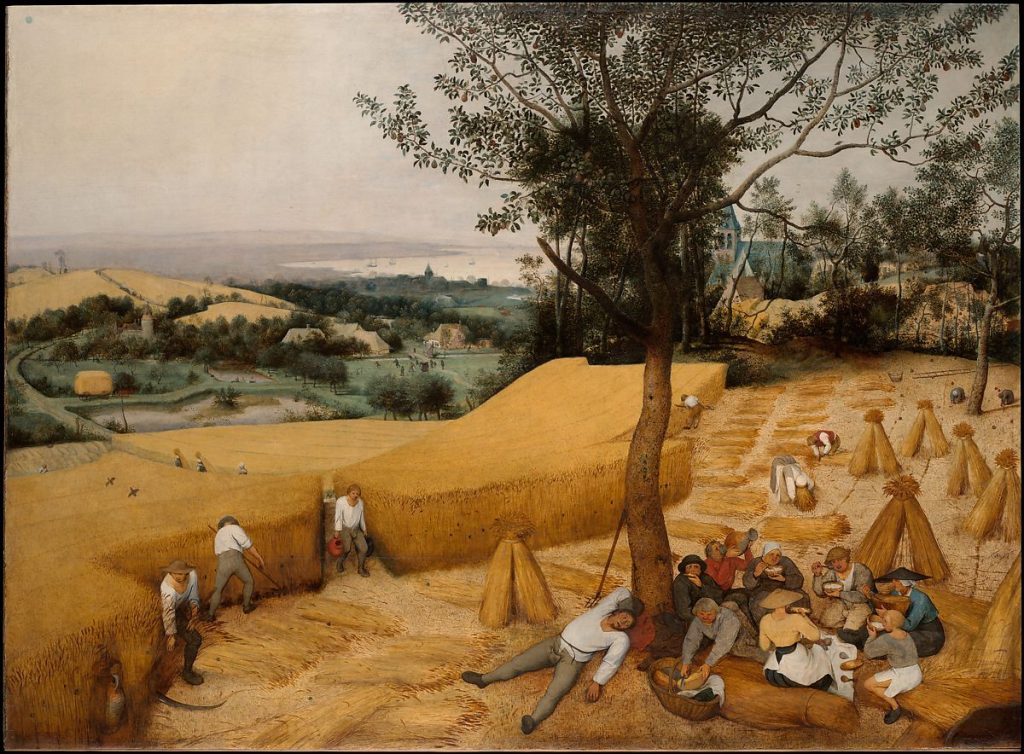
11)Reporting person: Sam Wallman (United Workers Union, Australia)
Title of a piece of art: A student rubber their eyes
Author: Sam Wallman
Type/date: Comic/2019
Current location of the work of art: Melbourne University Student Union
It refers to labour because…: 12 page publication looking at university students and workers organising in support of one another throughout Australian history.
LINK to the Comic.
12)Reporting person: Darcy du Toit (University of the Western Cape, South Africa)
Title of a piece of art: The Fourth Estate
Author: Giuseppe Pellizza da Volpedo
Type/date: Painting/1900
Current location of the work of art: Museo del Novecento, Milan
It refers to labour because…: It depicts a moment during a strike.
It has been chosen because…: It captures different human aspects of industrial conflict.
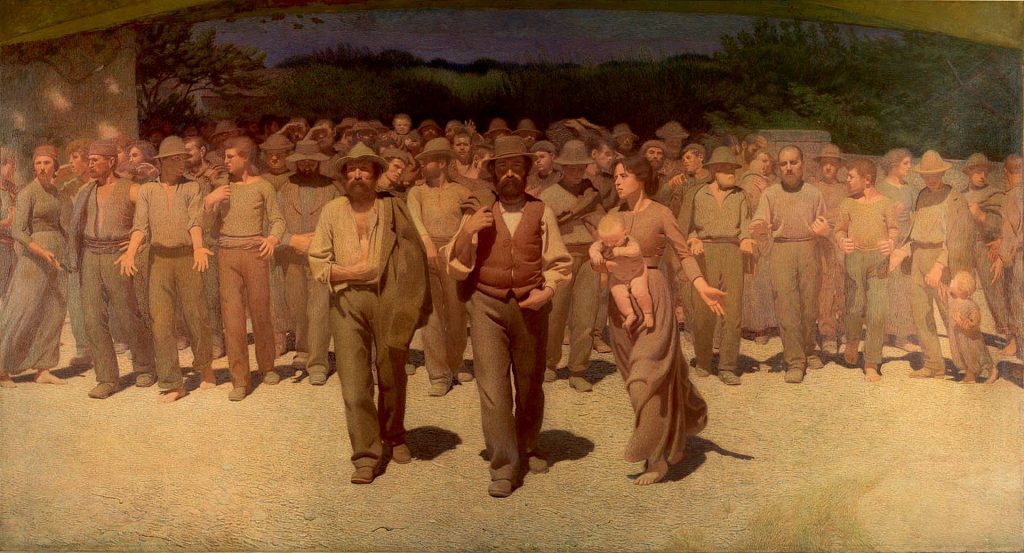
13)Reporting person: Barbara Surdykowska (NSZZ Solidarność)
Title of a piece of art: Podaj cegłę (Pass a brick)
Author: Aleksander Kobzdej
Type/date: Painting/1950
Current location of the work of art: National Museum in Wrocław
It refers to labour because…: Podaj cegłę (Pass a brick) by Aleksander Kobzdej is a painting depicting three working bricklayers. It was painted in 1950, when all Poles was rebuilding Warsaw, which was completely ruined during World War II. The city was home to hordes of young people who came from all over the country; donations were also flowing in from all sides, collected by the Social Fund for the Reconstruction of the Capital, established in 1945. Although the decision to rebuild the city was of a political nature, in line with the expectations of Joseph Stalin, its implementation would not have been successful without the genuine commitment of Poles from all over the country. The enthusiasm that emanates from this picture is therefore not only propaganda in nature but reflects the real faith of society in the sense of recreating the destroyed Warsaw.
It has been chosen because…: I chose the picture to show a bit of the history of Warsaw and because it can be compared with the second in the pair, which are „Ceglarki” – Women Bricklayers.
As a complement to the painting Pass the brick, Kobzdej also painted in 1950 the painting Ceglarki (Women Bricklayers) – this time depicting three women (National Museum in Warsaw). Unlike men who are bursting with energy, brick women were shown resting from work. Perhaps this is an illustration of the „other side of the coin”: the post-war reconstruction of the country brings not only joy, but also great fatigue of people who often work excessively. Or maybe, juxtaposing these two paintings, the artist referred to the popular contrast of „active” men and „passive” women? As noted by Ewa Toniak, the author of the book Olbrzymki: Kobiety i Socrealizm (title: Giants: Women and Socialist Realism), this image strongly exposes the stillness, even inertia, ascribed to women in the cultural tradition.
14)Reporting person: Barbara Surdykowska (NSZZ Solidarność)
Title of a piece of art: Strajk, Strike
Author: Stanisław Lentz
Type/date: Painting/1910
Current location of the work of art: National Museum in Warsaw
It refers to labour because…: Anger, the working class, 1905 – everything seems clear.
It has been chosen because…: „Strike” refers to the best examples of German realism. Its characteristic, elongated composition, focusing attention on the faces and hands of the portrayed, is reminiscent of Wilhelm Leibl’s painting „Three Women in the Church”.

MP 84; Lentz, Stanisław (1861-1920) (malarz); Strajk; 1910; olej; płótno; 118 x 74; [141,5 x 97,5 x 10] 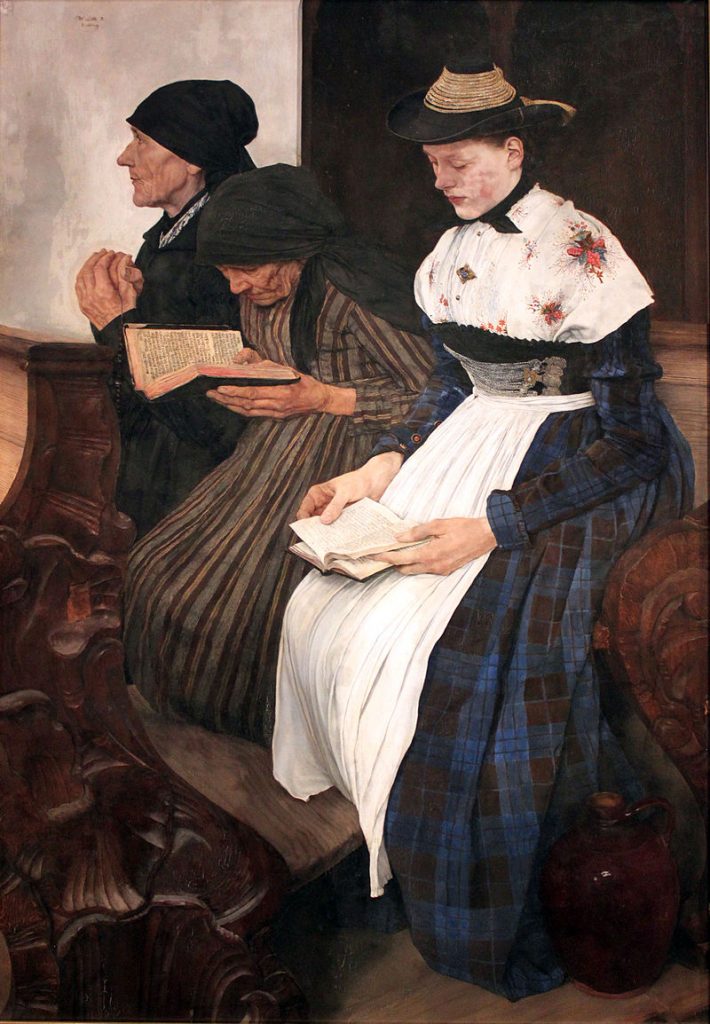
15)Reporting person: Barbara Surdykowska (NSZZ Solidarność)
Title of a piece of art: Bociany, Storks
Author: Józef Chełmoński
Type/date: Painting/1900
Current location of the work of art: National Museum in Warsaw
It refers to labour because…: A break from farming.
It has been chosen because…: It is simply the painting that is very recognizable in Poland that’s why I chose it. The son brought his father a meal – in the so-called doubles, which we see resting on the peasant’s legs. With his left hand the peasant holds the doubles, in the right one he holds a wooden spoon. The doubles most likely contain potatoes or groats cooked by the wife and curdled milk because such simple and cheap dishes were eaten by the peasants on a daily basis.
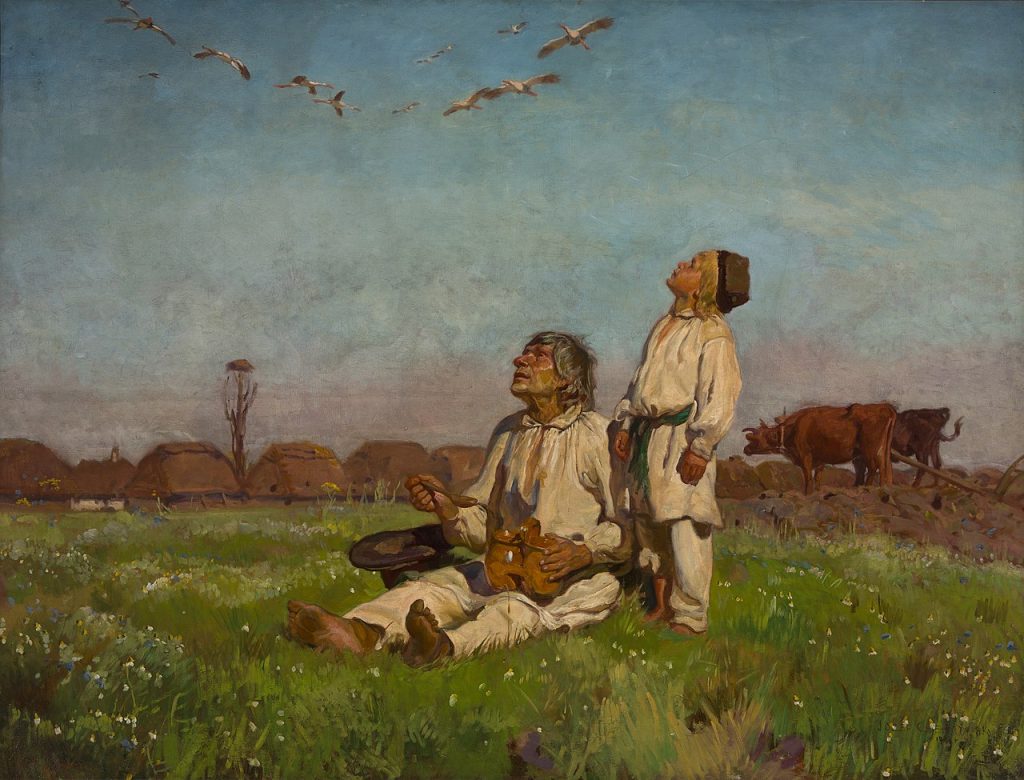
16) Reporting person: Barbara Surdykowska (NSZZ Solidarność)
Title of a piece of art: Szofer niebieski , „The Blue Chauffeur”
Author: Andrzej Wróblewski
Type/date: Painting/1948
Current location of the work of art: National Museum in Wroclaw
It refers to labour because…: It is definitely not a picture about a bus driver’s job.
It has been chosen because…: I chose the painting because Andrzej Wróblewski is one of my closest painters. If you don’t know him, google it because it’s worth it.
Andrzej Wróblewski painted „The Blue Chauffeur” very young, two years before the „Execution” series, simultaneously with „The Sunken City”. He was then twenty-four years old.
Using abstract flat spots, Wróblewski constructs an equally abstract situation from everyday life.Often the picture is interpreted as follows: There is no passenger sitting next to the chauffeur, perhaps he has already got off, that is, he has died, has been taken to his destination, because – man is destined to die. It is the end of the earthly journey.
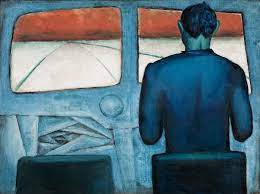
17)Reporting person: Alan Hyde (Rutgers University, USA)
Title of a piece of art: Sometimes I Daydream of Flying Away
Author: Jay Lynn Gomez (formerly Ramiro Gomez)
Type/date: Painting/2019
Current location of the work of art: Charlie James Gallery, Los Angeles
It refers to labour because…: Daydreams of man cutting grass.
It has been chosen because…: Much of Gomez’s art celebrates the dignity of labor.
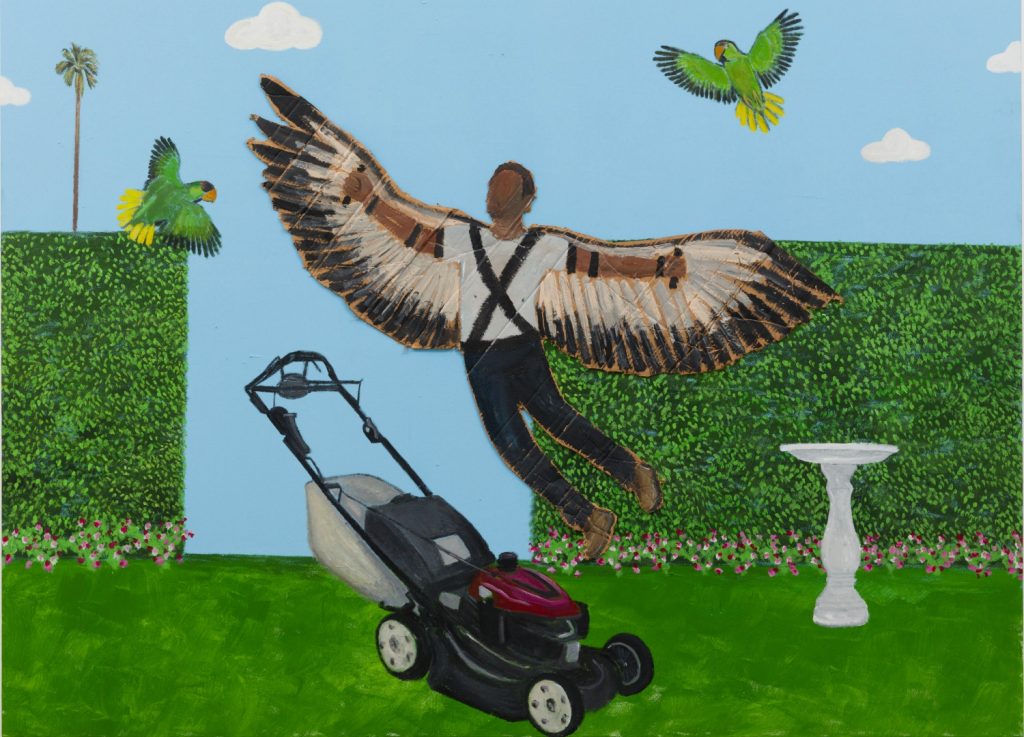
18)Reporting person: Alan Hyde (Rutgers University, USA)
Title of a piece of art: Lupita 2
Author: Jay Lynn Gomez (formerly Ramiro Gomez)
Type/date: Painted bronze/2017
Current location of the work of art: Greg Kucera Gallery
It refers to labour because…: Cleaner at one with bag of refuse.
It has been chosen because…: Simultaneously realistic, somber, and dignified.
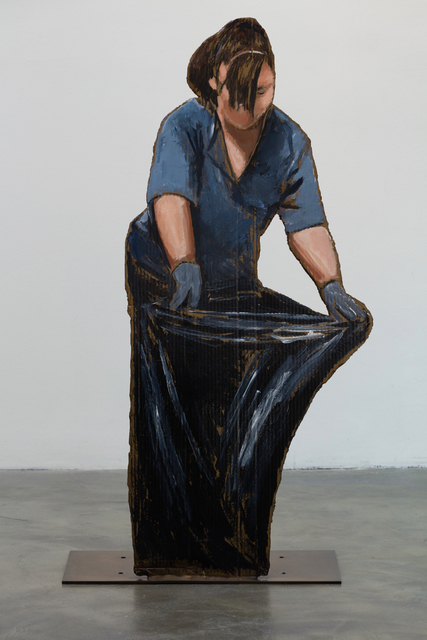
19)Reporting person: Alan Hyde (Rutgers University, USA)
Title of a piece of art: Las Meninas
Author: Jay Lynn Gomez (formerly Ramiro Gomez)
Type/date: Print/2013
Current location of the work of art: all sold to private collectors
It refers to labour because…: Shows the unseen labor behind subjects of European portrait.
It has been chosen because…: Confrontation with European masterpiece.
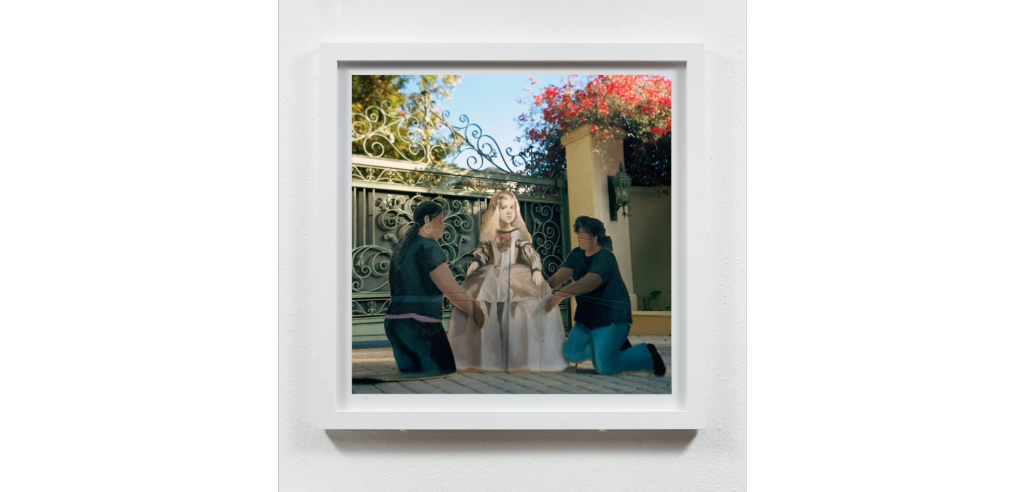
20)Reporting person: Claire Marzo (Paris East University (UPEC), France)
Title of a piece of art: Installation: 'Captures of tweets that mention 'sleep’, In ’24/7, Exhibition on time and work’
Author: Tekja, as shown in Somerset House, London, UK, 2019
Type/date: Installation, Exhibition/2019
Current location of the work of art: –
It refers to labour because…: Beautiful installation and exhibition questioning the relationship between labour, time and technology.
It has been chosen because…: „Have you ever wondered how much more productive you’d be if you didn’t have to sleep? Technology was meant to make life easier, but instead it’s created an always-on culture, meaning we’re always available and there’s always something happening on our smartphones, which never leaves our sides”.
LINK to the exhibition.
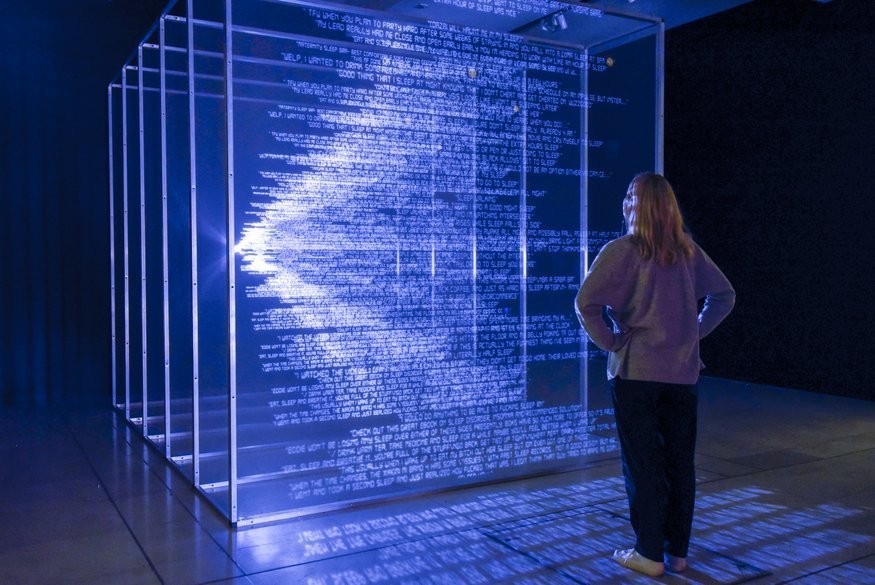
21)Reporting person: Claire Marzo (Paris East University (UPEC), France)
Title of a piece of art: Untitled, Photo gallery of the CEPASSOC project
Author: Unknown, collective
Type/date: Diverse/2021
Current location of the work of art: https://cepassoc.hypotheses.org/galerie-gallery
It refers to labour because…: The project members were asked to take pictures in the different cities they live in to capture the major labour changes brought by technology and the pandemic.
It has been chosen because…: These photos show how platform workers have invaded the streets of main cities and capitales around the world.
LINK to the gallery.

22) Reporting person: Calogero Massimo Cammalleri (University of Palermo — TTRT – temilavoro.it, Italy)
Title of a piece of art: Fisherman’s expectations
Author: Kaloscam
Type/date: photograhp/1994
Current location of the work of art: private collection
It refers to labour because…: Worried for the future when labour is certain, but results are not.
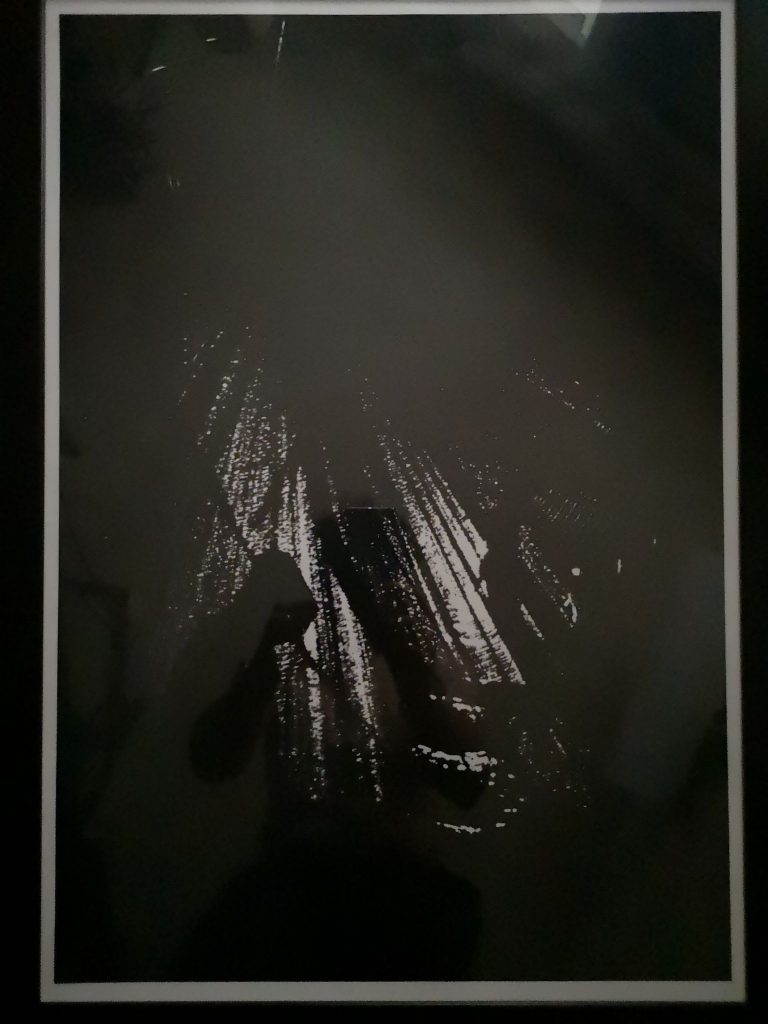
23)Reporting person: Judy Fudge (McMaster University, Canada)
Title of a piece of art: Incendiary, Marie-Joseph Angélique
Author: Kit Lang
Type/date: painting/2012
Current location of the work of art: Art Institute Canada
It refers to labour because…: Domestic slave who was hung for allegedly starting a fire in Montreal.
It has been chosen because…: Slavery is a form of compelled labour and Canada;s involvement in this form of work regime is not well known. It’s also beautiful.
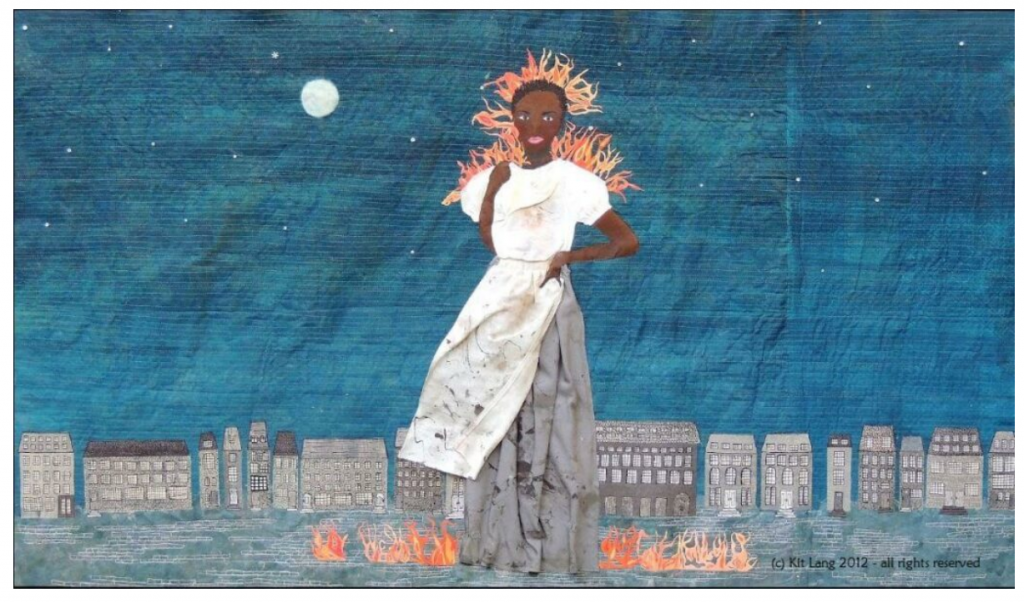
24)Reporting person: Filip Dorssemont (UC Louvain, Belgium)
Title of a piece of art: Monument to Labour
Author: Constantin Meunier (sculptures) and Mario Knauer (architect)
Type/date: Monument – sculpture/1930
Current location of the work of art: Bassin Vergoote, Laeken (Brussels)
It refers to labour because…: This work of Art was intended to glorify Labour. It focuses on the antropological dimension of labour as a means for mankind to regenerate itself and on its relation with Nature , represented by 4 branches of labour emblematic for the 4 elements.
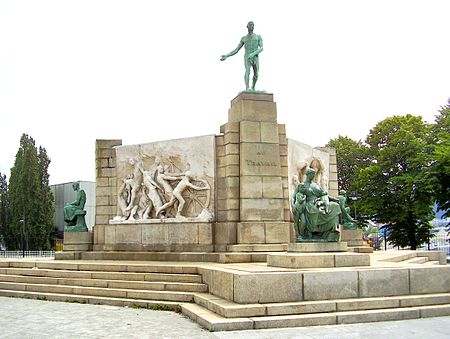
25)Reporting person: Catharina Lopes Scodro (University of São Paulo, Brazil)
Title of a piece of art: Manifestación y Desocupación
Author: Antonio Berni
Type/date: Painting/1934
Current location of the work of art: MALBA/Argentina
It refers to labour because…: The painting “Manifestación y Desocupación”, of the 1930s, is related to the post-Crisis economic depression scenario of 1929, representing the manifestation of workers claiming for food and job. It should be noted that the painted workers do not belong to a uniform group, what enables to identify the plurality of gender, age group and ethnicity.
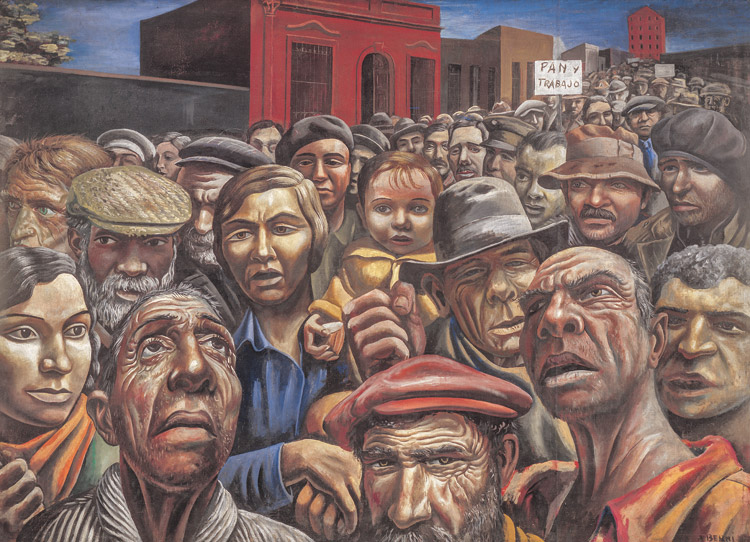
26)Reporting person: Catharina Lopes Scodro (University of São Paulo, Brazil)
Title of a piece of art: Acidente de Trabalho
Author: Eugênio de Proença Sigaud
Type/date: Painting/1944
Current location of the work of art: Museu Nacional de Belas Artes
It refers to labour because…: Known as the „painter of the workers”, Sigaud sought to represent the productive scenario of the workers in the painting „Accident at Work”, placing a body on the floor in the central region. This body would be the representation of the accidented worker who, despite of causing astonishment to the crowd, does not lead to the paralysis of activities – signaling, therefore, his invisibility.
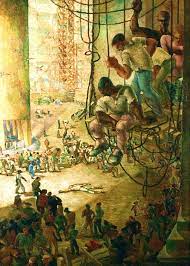
27)Reporting person: Catharina Lopes Scodro (University of São Paulo, Brazil)
Title of a piece of art: Operários
Author: Tarsila do Amaral
Type/date: Painting/1933
Current location of the work of art: Palácio Boa Vista
It refers to labour because…: The painting “Operários” is related to the diversity of workers during the industrialization period in Brazil. Thus, the painting dialogues with the emergence of factories and the migration to the State of São Paulo.
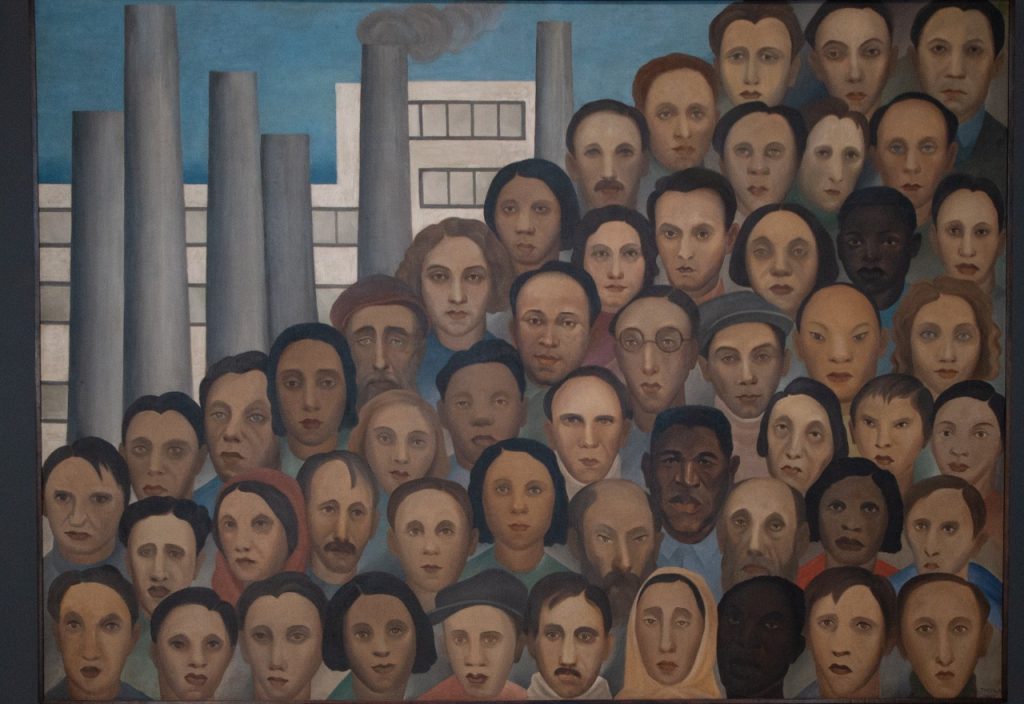
28) Reporting person: Catharina Lopes Scodro (University of São Paulo, Brazil)
Title of a piece of art: O Café
Author: Candido Portinari
Type/date: Painting/1935
Current location of the work of art: MALBA
It refers to labour because…: The painting “O Café” portrays the routine of workers in coffee plantations in Brazil. In the painting, it is possible to verify the presence of men and women, especially blacks, performing manual services in the harvest, in the 20th century. It should be noted that the theme „coffee” is very present in the painting of Candido Portinari, for being the son of Italian immigrants who worked in the field.
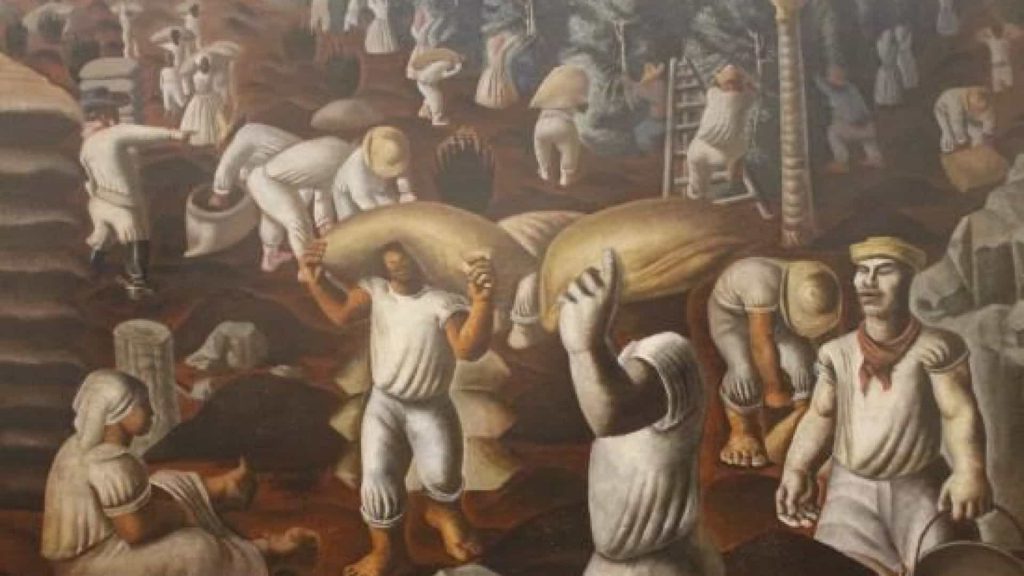
29) Reporting person: Catharina Lopes Scodro (University of São Paulo, Brazil)
Title of a piece of art: Não há vagas
Author: Rubens Gerchman
Type/date: Painting/1965
Current location of the work of art: MALBA
It refers to labour because…: The painting “Não há vagas” dialogues with the period of Civil-Military Dictatorship in Latin America, contrasting the colors of the Brazilian flag and the representation of the mass of workers. This painting has great critical potential related, above all, to the scenario of intense unemployment.
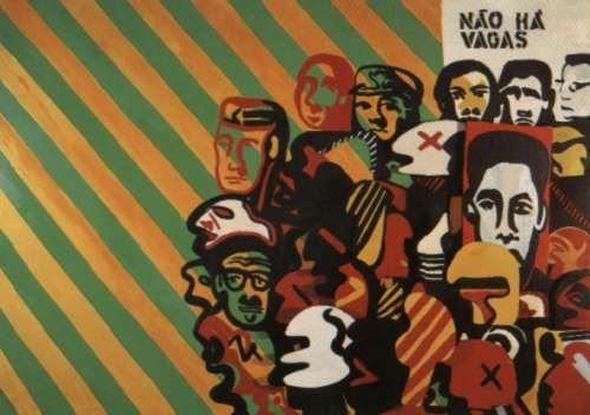
30)Reporting person: Marta Otto & Izabela Florczak (University of Lodz, Poland)
Title of a piece of art: “Follow your dreams, cancelled”
Author: Banksy
Type/date: Street Art
Current location of the work of art: Chinatown, Boston, Massachusetts
It refers to labour because…: What comes to your mind when you see this image? Do you see a hard working man with hunched shoulders and a long discouraged facial expression? The location of this art is very crucial to it’s meaning- Chinatown, Boston, Massachusetts- a low-income district whose habitants are less likely to reach, let alone follow their dreams …
It has been chosen because…: Isn’t it an obvious choice for someone coming from 'the city of murals’?A city once called 'a promised land’, that nowadays is more known as the Polish Manchester. Street art naturally blends into the post-industrial (red brick) fabric of the city. Walking along the streets of Łódź, you will find plenty of street art by some of the world’s best names. We do hope that on the occassion of your next visit to Poland (in 2023 at the latest!) you will decide that it is indeed worth checking it out.

31)Reporting persons:
- Elaine Dewhurst, University of Manchester, School of Social Sciences, Faculty of Humanities, Law
- Sarah Campbell, Manchester Metropolitan University, Faculty of Health, Psychology and Social Care, Health and Social Care
- Ruth Edson, Manchester Art Gallery
- Suzanne Lacy, Artist, University of Southern California, Roski School of Art and Design
Title of a piece of art: Uncertain Futures: Inequalities affecting women over 50 years at work in Manchester
Author: Suzanne Lacy (LINK)
The artwork for Manchester Art Gallery is led by California-based artist and academic Suzanne Lacy, professor at the University of Southern California. Lacy’s artworks are socially engaged performance pieces that seek to build new knowledge, influence social action and promote meaningful change (Malik, 2019). The artwork aims to make visible the issues of worklessness for women over 50 and their challenges with respect to both paid and unpaid labour. The participatory artwork is centered in the Gallery and will result in a collection of narratives from 100 Manchester women over 50 years from diverse backgrounds. The artwork essentially gives voice to these women to describe and expose the inequalities they have faced and to uncover their overlooked strengths. The development of a diverse Advisory Group of women is the cornerstone of this art project. The Uncertain Futures project has convened group meetings most weeks for the past year. During this time the members have helped develop the main focus for the research, and have formed into small subcommittees that are interested in specific elements of the research, artwork, civic programme and media campaign. They include representatives of inter alia, Wai Yin Society, Ethnic Health Forum, Women’s Voices, GM BAME Network, Wythenshawe Good Neighbours, and Manchester Carers Network and MCC Work and Skills, among others. This exceptional group of local leaders are all over 50 and represent particular lived experiences around work. They have developed a programme of civic engagement that is an important part of the artwork, along with generating innovative media to bring attention to their issues. The Advisory Board is engaged in supporting the shaping of the artwork and the research project.
The main research question addressed through the participatory artwork is what challenges do women over 50 years face in relation to work in Manchester? This is participatory art-led research study from which the social science research team (law and social care) will draw out thematic challenges facing women over 50 in Manchester with the aim of raising public awareness and effecting policy change. The participatory artwork will result in a collection of narratives from 100 women over 50 years of age from diverse backgrounds in Manchester around their experience of work. The artwork essentially gives voice to these women to describe and expose the inequalities they have faced in relation to work and to uncover the overlooked strengths of the women. The research team will then utilise social science and legal methodologies to analyse the collected narratives in addition to relevant employment law tribunal cases on equality law to identify the emerging themes. Multimedia policy briefings will be produced thematically to enhance engagement and impact. The participatory artwork, narratives, case law and multimedia policy briefings will be hosted on an Uncertain Futures website which will be designed to focus on these identified themes and raise public awareness of these issues. The idea is to use this website as a hub for policy impact.
As part of a participatory research project, Uncertain Futures, we have identified that ageism and age-discrimination are heavily intersected by race, migration, gender, disability and socio-economic background. We have designed a matrix over a year-long period of participatory and exploratory engagements between the Advisory Group and the research partners. The matrix indicates that within these work packages (access to work, in-work experiences, Covid-19 impact, work, ageing and retirement) there is a common intersection between age and race, migration, disability, gender and socio-economic background. These work packages are currently been used to frame the interview questions and will form the basis of the research themes to be investigated.
32) Reporting person: Pietro Manzella (Association for International and Comparative Studies)
6 Books covers
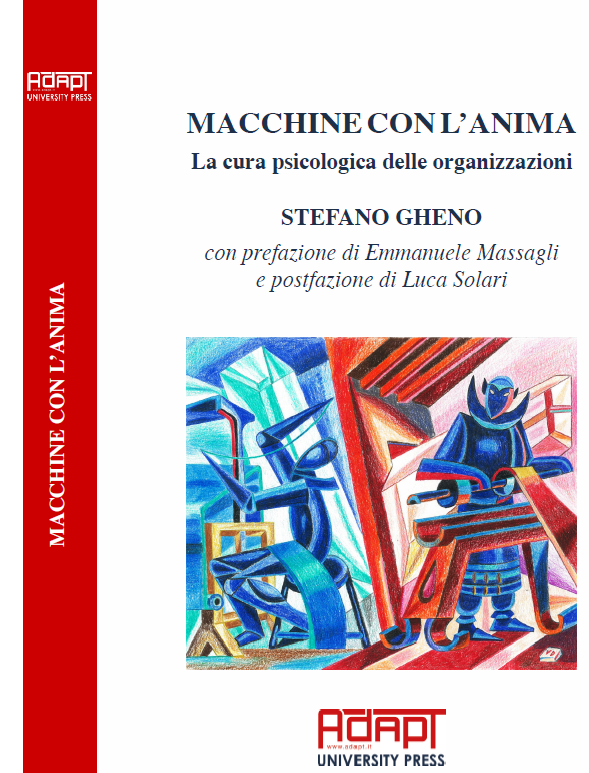
- Machines with a Soul
The cover, designed by Lavinia Serrani, is a free interpretation of Tornio e telaio (Fortunato Depero, 1949). A mechanical man, a futuristic hope of overcoming human frailty through technological development. Two men, or rather two faces that Depero characterizes through coloss: a tone of red, which echoes speed and strength, a contemporary sturm und drang, and a more serene blue, but a bit aseptic. The relationship between man and machine is the central theme of Stefano Gheno’s book. First of all, between man as a person and machine as an organization: a relationship that provides the mechanism with a soul.
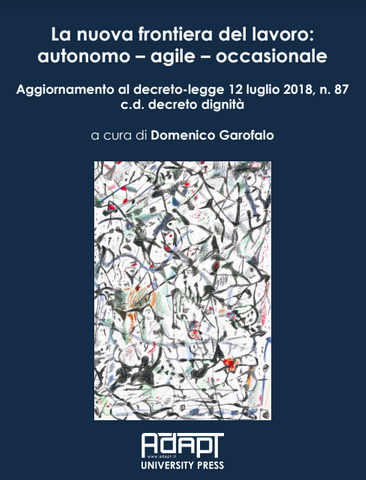
2. The new frontiers of occasional and autonomous work
The cover image, designed by Lavinia Serrani, is a free interpretation of Jackson Pollock’s Enchanted Forest enriched by some stylistic contaminations ranging from Kandinsky, without his typical geometric rigidity, to Gorky, in the delicacy of the forms and chromatic expressiveness. The image wants to enclose, in a dynamic dimension, that idea of network and complex relationships that is typical of contemporary socio-economic relations. A world of work that at first glance seems irrational, elusive, as it is subject to different readings and interpretations that are often contradictory.
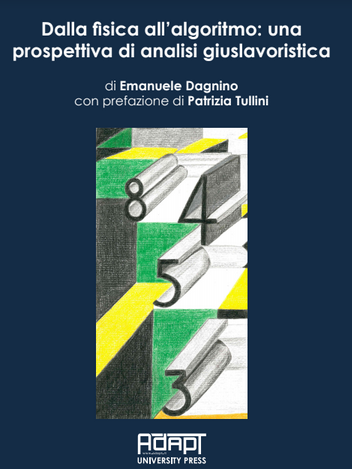
3. From Physics to Algorithms: A Labour Law Perspective
The image on the cover – a re-elaboration of Giacomo Balla’s work Numeri innamorati (Numbers in Love) by Lavinia Serrani – is intended to recall the paradigm shift underlying today’s conception of reality, which also impacts on the world of work and labor law. Just as in the Futurist dialectic the love for technical and technological progress is accompanied by the love for mathematics, in the same way in today’s culture these two factors proceed in close connection and are often considered symbols of human progress.
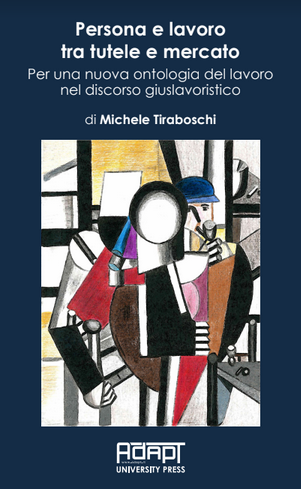
4. Individuals and Employment between Protection and the Market
The cover image, designed by Lavinia Serrani, is a free interpretation of the painting Les trois camarades by Fernand Léger and was chosen by the author for three main reasons. The first reason is affective: Les trois camarades was used by the publishing house Einaudi for the original cover of Primo Levi’s The Monkey’s Wrench, which inspired the entire volume, as labor law can and must today develop a dimension relating not only to freedom at work but, even more so, to freedom of work. The second reason is linked to the technique adopted by Léger, one of the first artists to free color from all constraints, dissociating it from the form that is filled with it. The third and final reason relates to the use of color itself, which in Léger’s work is plural and variegated, just as modern labor is once the totalizing paradigm of „productive labor” that emerged with the first industrial revolution has been overcome.
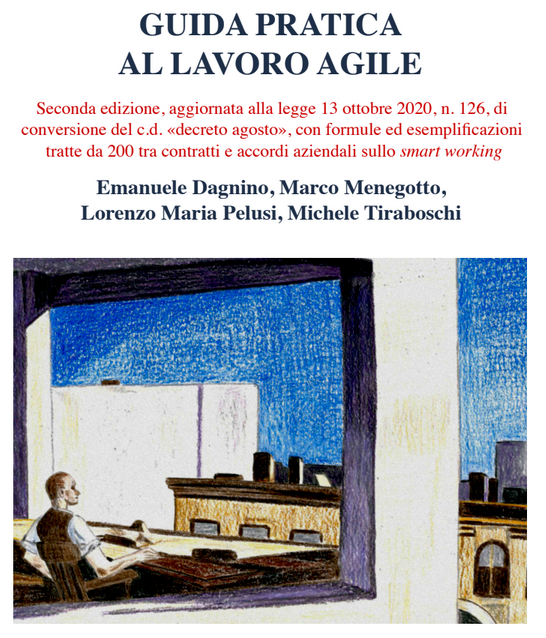
5. A guide to Agile Working
The cover image, designed by Lavinia Serrani, is a free interpretation of Office in a small city (Edward Hopper, 1953). A man at an office table looks at the city silhouetted against the blue sky, almost dreaming of escape. But at the same time the sensation is one of profound loneliness and isolation from which we are saved through the gaze occupied by the elsewhere. Loneliness, evasion, freedom. Deep themes that might seem distant from the content of a practical guide such as the one that develops in the following pages. But these themes are at the origin, of the choice of agile work (remote work) and of its concrete regulation by law and, above all, by agreement (individual and collective), as shown by the almost 200 contracts analyzed in the volume, which indicate multiple and different points of balance in the execution of work. A job that can be, and often this is the promise, a liberation from the constraints of space and time typical of twentieth-century models but at the same time the confinement in a domestic environment that can be a prison.
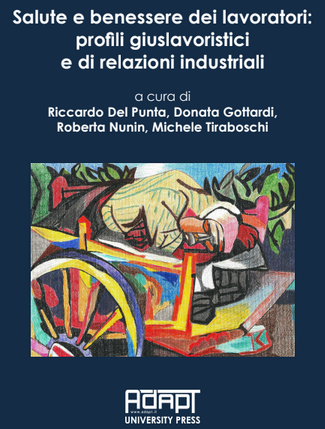
7. Employee wellbeing: labour law and industrial relations aspects
The cover image – a free re-elaboration of the work Carrettiere siciliano addormentato by Renato Guttuso, edited by Lavinia Serrani – intends to refer to the theme of the health and well-being of the worker, the subject of this volume, in a twofold perspective. On the one hand, it goes against the rhetoric of certain aesthetics of work that wants to idealize the work activity. On the other hand, the subject evokes in the observer one of the most iconic images of the epidemic emergency related to Covid-19 on the labor front, that of the exhausted nurse asleep on her desk at the end of her shift. We want, therefore, to pay a heartfelt tribute to the efforts of those who with their commitment has given and gives the sense of fusion between ethics and aesthetics of work that transpires from the image.
